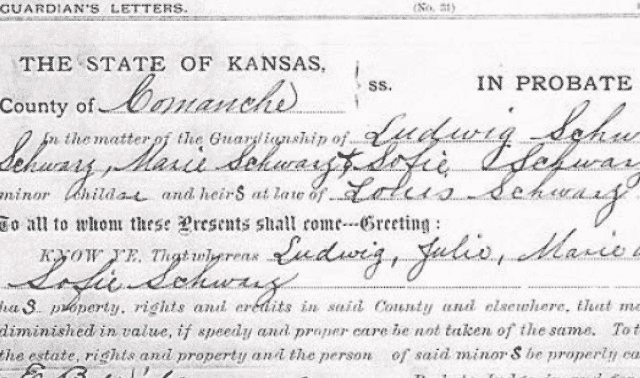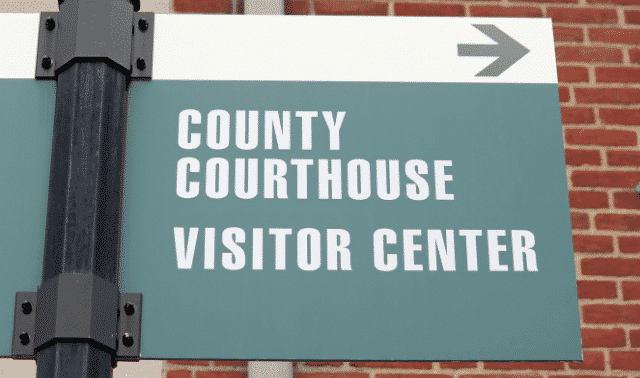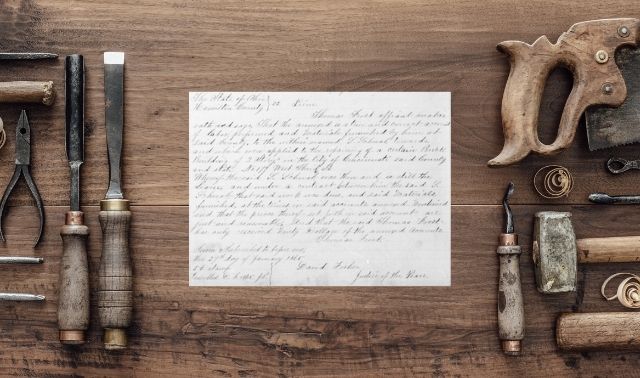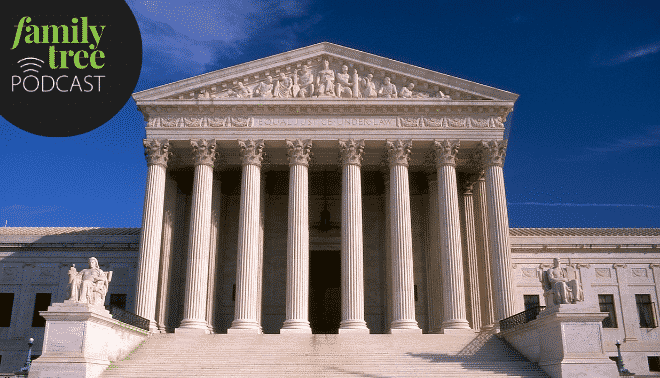
With the wonders of the internet, who needs to go to old county courthouses to blow the dust off heavy deeds books and pore over criminal courts records? You do!
Sure, all kinds of websites, archives, history centers and libraries have basic census information for your family. And it’s frequently possible to get copies of family and regional histories through interlibrary loan or genealogical and historical societies. But if you want to know all the precise details about the fight over your great-great-grandmother’s estate, property transactions involving your grandparents, and the criminal changes filed against your great-grandfather, it’s worth a trip to the courthouse.
You’re especially likely to end up at the county courthouse if you’re looking for records outside the nation’s largest cities. (Prime exceptions include Connecticut and Rhode Island, whose counties don’t have formal governments, and Alaska and Louisiana, whose “counties” are called boroughs and parishes, respectively.) Counties with populations under 50,000 accounted for nearly 75 percent of all county governments in 1990, according to the National Association of Counties, and there’s no reason to think that has changed. Whether you’re headed for the county or city or township courthouse. These tips will help you make the most of the trip.
1. Download and fill out a Research Repository Checklist.
It’ll help you plan your visit, bring appropriate materials and leave extra stuff behind. Bring this checklist with you to the courthouse, and list which office has the types of records you’re looking for.
Diane Haddad
2. Arrive as early as possible in the workday.
You never know how much time your research will take.
Diane Haddad
3. Know the location of the records you’re looking for.
Many of the records you’ll be seeking—private land transactions, court actions, vital records—were filed at the county courthouse. But from state to state, the office that has the records you want doesn’t always have the same name. It’s a pretty safe bet that the recorder of deeds has private land-transfer documents, and that the clerk of courts holds all the information you need on civil and criminal casts. But where you’ll find vital records can vary considerably.
Drill down into each state’s county pages at USGenWeb. Most of the site’s county pages tell which office is responsible for which records; frequently, they also list the address, copying fees, and hours during which genealogists are allowed to do research.
Melanie Rigney
4. Learn county boundary changes.
Even if you’re a genealogy newbie, you’ve probably discovered that counties have been created and have disappeared in virtually every state. It’s important to know which county your ancestors lived in when they were selling land or suing their neighbors, and which county is now the administrator for that area. This type of history is important to check before you leave home, even if the ancestors in question never moved an inch after homesteading—the boundaries for the county they lived in may have.
Further, while it’s not common, it’s also not unheard of for a piece of property to have straddled a county line; if that’s the case, as long as you’re in the neighborhood, it can’t hurt to check both counties for records involving your ancestors. And boundary changes aren’t just a thing of the past—today, government remains a dynamic, changing force. One current trend is for counties and cities to combine governmental functions. Before you leave home, make sure you know where the record you’re seeking is currently housed.
Melanie Rigney
5. Find out what they have.
It’d be a shame to traipse halfway across the country only to find that 1850 probate record you want is lost in the mists of time because the county in question didn’t star saving documents until 1855. Perhaps the county is currently microfilming a particular decade; as a result, all records are unavailable for the next six months. Or maybe everything from the period you’re researching was transferred to the state vital records office or to the state archives since the county website was last updated. Call to confirm the records are, in fact, on premises.
These records represent just a sampling of what you might find at your ancestors’ county courthouses:
- adoptions
- apprenticeships and indentures
- bastardy cases
- business and professional licenses
- coroner’s files and inquests
- court proceedings
- guardianship papers
- homestead files
- insanity and commitment hearings
- jury lists
- justice of the peace records
- land deeds, surveys and plat maps
- livestock brands and marks
- mortgages and leases
- name changes
- naturalizations
- orphans records
- poorhouse/county farm records
- prenuptial agreements
- property foreclosures
- tax rolls
- vital records
- voter registrations
- wills and probates
- wolf-scalp bounties
Sharon DeBartolo Carmack
6. Focus your search.
If you’re fortunate enough to have several family lines who lived in the same area several years, it’s tempting to try to work them all in an afternoon. Don’t! It’s hard enough to pore over land records and estate records and litigation involving one family in a day. Add in a different set of names and a different set of dates at the same time, and you’re going to miss something significant about one or the other. A better strategy is to decide which offices and records you want to check for a specific family Then, when you’re checked off everything off that family’s list, move on to the next one. For me, approaching it in the opposite way—“I’ll check the land records for all my ancestors in Monroe County”—takes more time, and I almost always miss an interesting record as a result.
Melanie Rigney
7. Time your trip wisely.
Several years ago. My sister, brother and I went to the Giant County, Wis., courthouse as part of a bigger genealogical trip. We checked in advance the years for which records were on file, the office that held out records of interest and its hours. It wasn’t until we got there, however, that we were told genealogists had to register in advance to view records. Worse, only a few (I believe the number was five) researchers were allowed access at any one time, and all those slots were booked for the day. Yes, you would’ve thought the county employee to whom I spoke before the trip would’ve mentioned that detail, but she didn’t. Since then, I’ve always asked if the office has specific restrictions for genealogical research that I need to know before making a trip.
Melanie Rigney
8. Dress professionally but in comfortable, washable clothes.
You may be on your feet a lot of the day in tight, hard-to-reach or dusty spaces. Yet, you’ll get the respect you deserve as a researcher when you look presentable.
Diane Haddad
9. When you need to ask the staff a question, think of the most direct way to ask.
When you get to the courthouse, don’t expect clerks to act as your personal research assistants. They usually don’t share your enthusiasm for family history, and assisting genealogists isn’t their primary duty. When asking for help, it’s best not to go into detail about your research. Give them only enough information to help you find what you’re looking for. Be as pleasant and friendly as possible, even though the person behind the counter might not be. Remember: The clerk has what you want—the records.
Like most of the rest of us, many government workers feel they’re overworked and underpaid. The people who work in the offices you’ll visit are kept busy by elected officials, constituents, lawyers and assorted crazies who come into the office.
Family historians sometimes fall into the final category, in their opinion. (Not everyone shares our enthusiasm!) Be as specific as possible with your request: “I’d like a copy for family history purpose of the birth certificate of my father, Bernard Rigney. Who was born in Kennebec on March 28, 1919.” Such clarity will get a much more pleasant (and prompt) response than “I was hoping to see a list of people born in Lyman County before 1920.”
Consider going the extra mile for a particularly helpful clerk. Send a thank-you note, some candy or even flowers, and mention your visit in some way so the clerk will remember them—and be even more helpful the next time they visit the courthouse.
Sharon DeBartolo Carmack
10. Avoid being a pest.
Do not go back to the person who got the record for you and ask if she thinks the number in that land record looks more like a one or a seven. Don’t ask why your great-grandmother’s name is listed one way in documents regarding her estate settlement, when everywhere else she’s listed in a different way. The worker won’t know.
If you want a second opinion, ask a fellow researcher. You’ll almost always find someone else delving into his history at the same table where you’ve been told to sit. If the clerk says she doesn’t have a record, it’s fine to ask her to check a second time. But if it still doesn’t turn up, consider other possibilities. I once was sure a death record had to be on file—after all, the family had lived in the county for 40 years, and my great-great-grandmother was buried there, so how could she not have died there? A thoughtful county worker suggested I check her estate file—there, I learned she spent the last year of her life with a daughter more than 300 miles away.
Melanie Rigney
11. If you can’t find what you’re looking for, ask politely whether someone in the county offices has a lot of experience with the historical records.
If that person is available, he or she may be able to tell you whether an ancestor could have married by banns, or how likely it was that African Americans would’ve had their deaths reported or estates filed during Jim Crow years.
Diane Haddad
12. Be prepared.
Many offices have very specific requirements as to what a family researcher may take into the records area. Sometimes, you’ll be allowed to take only pencils and a notepad. Even if you’re told the office doesn’t have such restrictions, it’s best to have a half-dozen pencils and the details of what information you are seeking written on a notepad. Don’t count on a convenient hookup for your laptop—or even on being able to use it.
Similarly, carry plenty of change for parking. It’s not free at every courthouse, and lots where you can park for the day and pay when you come in or leave aren’t always available. And be prepared to pay in cash or with a personal check for any copying—not every office will take credit cards.
It’s always a good idea to write or call the courthouse prior to your visit to see what hours it’s open and whether it will be closed for any special reason, such as a state holiday. Other questions to ask:
- Do you have a photocopier for public use? How much do copies cost?
- Can I make change there, or should I bring coins? Or, is there another way to pay for copies?
- How much does it cost to get a certified and non-certified copy of a record?
- Where’s the nearest place to eat? To park?
- Is the building handicapped-accessible?
- Can researchers take in backpacks or tote bags?
- Are laptop computers allowed?
- Do I need to see a particular person about looking at a certain record?
- Does the office close for lunch?
- Are any records stored elsewhere, and how can I get access to them?
- Do you have a pamphlet outlining the repository’s holdings?
Sharon DeBartolo Carmack
13. Carry a minimum of materials with you.
There probably won’t be a secure place to set up a laptop computer or table space where you can spread out your notes.
Diane Haddad
14. Confirm copying policies ahead of time.
You may be permitted to use a wand scanner or the digital camera on your phone, or you may have to buy a copy card. Some places only permit taking notes.
Diane Haddad
15. Make copies or scans of everything.
Even if you already have a copy from another source. Write down every single solitary thing in the record, including misspellings and details that don’t jive with information you already have about the family. My sister and I had viewed one of our lines’ 1880 Hardin county, Iowa, census record at Family History Centers and at a National Archives and Records Administration facility. Every time, we’d read right over the race box, as we were quite sure it said white. But when we visited the Hardin County Courthouse and gave my brother this transcription duty (thinking the two of us would handle other documents), we found out our great-great-grandfather was listed as mulatto. This new information led us on an entirely new direction in our research.
When researching your own family, be sure to read every detail. A criminal filing may turn up a “black sheep” about whom no one in the family ever talks; a probate file may provide information about nieces, nephews and cousins.
Melanie Rigney
16. Take a chance, as long as you’re there.
You may be going to the courthouse to check on your great-grandmother’s death certificate. As long as you’re there, see if there’s an estate folder or probate record on her. Ask the clerk of courts if there’s a surname index for court caves. Check the index of private property transactions to see if she and your great grandfather owned land you know nothing about. Yes, this seems to fly in the face of tip 7. But pointing you in the direction of an index isn’t a major inconvenience for the courthouse workers, even if they may act like it is. After all, it’s not every day (or even every decade, for that matter) that you get to some of the more-remote areas where your ancestors lived, and better to know nothing’s on file than to wonder after you get home.
Finally, don’t forget to leave the courthouse occasionally, too. While it’s a thrill to see records that were so important to your family, it’s just as exciting to visit the neighborhoods in which they lived. Leave the dusty files behind for part of your trip—and experience the lives behind those records.
Melanie Rigney
A version of this article appeared in the November 2003 issue of Trace Your Family History, with additional information from the December 2004 issue of Family Tree Magazine. Last updated: November 2024




